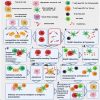Use of Salmonella Bacteria in Cancer Therapy: Direct, Drug Delivery and Combination Approaches
- PMID: 33738260
- PMCID: PMC7960920
- DOI: 10.3389/fonc.2021.624759
Use of Salmonella Bacteria in Cancer Therapy: Direct, Drug Delivery and Combination Approaches
Abstract
Over the years, conventional cancer treatments, such as chemotherapy with only a limited specificity for tumors, have undergone significant improvement. Moreover, newer therapies such as immunotherapy have undergone a revolution to stimulate the innate as well as adaptive immune responses against the tumor. However, it has been found that tumors can be selectively colonized by certain bacteria, where they can proliferate, and exert direct oncolytic effects as well as stimulating the immune system. Bacterial-mediated cancer therapy (BMCT) is now one example of a hot topic in the antitumor field. Salmonella typhimurium is a Gram-negative species that generally causes self-limiting gastroenteritis in humans. This species has been designed and engineered in order to be used in cancer-targeted therapeutics. S. typhimurium can be used in combination with other treatments such as chemotherapy or radiotherapy for synergistic modification of the tumor microenvironment. Considerable benefits have been shown by using engineered attenuated strains for the diagnosis and treatment of tumors. Some of these treatment approaches have received FDA approval for early-phase clinical trials. This review summarizes the use of Salmonella bacteria for cancer therapy, which could pave the way towards routine clinical application. The benefits of this therapy include an automatic self-targeting ability, and the possibility of genetic manipulation to produce newly engineered attenuated strains. Nevertheless, Salmonella-mediated anticancer therapy has not yet been clinically established, and requires more research before its use in cancer treatment.
Keywords: Salmonella species; bacteria-mediated cancer therapy; cancer; drug delivery; therapy.
Copyright © 2021 Badie, Ghandali, Tabatabaei, Safari, Khorshidi, Shayestehpour, Mahjoubin-Tehran, Morshedi, Jalili, Tajiknia, Hamblin and Mirzaei.
Conflict of interest statement
MH declares the following potential conflicts of interest. Scientific Advisory Boards: Transdermal Cap Inc, Cleveland, OH; BeWell Global Inc, Wan Chai, Hong Kong; Hologenix Inc. Santa Monica, CA; LumiTheraInc, Poulsbo, WA; Vielight, Toronto, Canada; Bright Photomedicine, Sao Paulo, Brazil; Quantum Dynamics LLC, Cambridge, MA; Global Photon Inc, Bee Cave, TX; Medical Coherence, Boston MA; NeuroThera, Newark DE; JOOVV Inc, Minneapolis-St. Paul MN; AIRx Medical, Pleasanton CA; FIR Industries, Inc. Ramsey, NJ; UVLRx Therapeutics, Oldsmar, FL; Ultralux UV Inc, Lansing MI; Illumiheal&Petthera, Shoreline, WA; MB Lasertherapy, Houston, TX; ARRC LED, San Clemente, CA; Varuna Biomedical Corp. Incline Village, NV; Niraxx Light Therapeutics, Inc, Boston, MA. Consulting; Lexington Int, Boca Raton, FL; USHIO Corp, Japan; Merck KGaA, Darmstadt, Germany; Philips Electronics Nederland B.V. Eindhoven, Netherlands; Johnson & Johnson Inc, Philadelphia, PA; Sanofi-Aventis Deutschland GmbH, Frankfurt am Main, Germany. Stockholdings: Global Photon Inc, Bee Cave, TX; Mitonix, Newark, DE. The remaining authors declare that the research was conducted in the absence of any commercial or financial relationships that could be construed as a potential conflict of interest.
Figures

Similar articles
-
Salmonella-Mediated Cancer Therapy: An Innovative Therapeutic Strategy.J Cancer. 2019 Aug 20;10(20):4765-4776. doi: 10.7150/jca.32650. eCollection 2019. J Cancer. 2019. PMID: 31598148 Free PMC article. Review.
-
Targeted cancer immunotherapy with genetically engineered oncolytic Salmonella typhimurium.Cancer Lett. 2020 Jan 28;469:102-110. doi: 10.1016/j.canlet.2019.10.033. Epub 2019 Oct 24. Cancer Lett. 2020. PMID: 31666180 Review.
-
Targeted Cancer Therapy Using Engineered Salmonella typhimurium.Chonnam Med J. 2016 Sep;52(3):173-84. doi: 10.4068/cmj.2016.52.3.173. Epub 2016 Sep 23. Chonnam Med J. 2016. PMID: 27689027 Free PMC article. Review.
-
Salmonella typhimurium may support cancer treatment: a review.Acta Biochim Biophys Sin (Shanghai). 2023 Feb 25;55(3):331-342. doi: 10.3724/abbs.2023007. Acta Biochim Biophys Sin (Shanghai). 2023. PMID: 36786073 Free PMC article. Review.
-
Salmonella-Mediated Cancer Therapy: Roles and Potential.Nucl Med Mol Imaging. 2017 Jun;51(2):118-126. doi: 10.1007/s13139-016-0415-z. Epub 2016 Jun 1. Nucl Med Mol Imaging. 2017. PMID: 28559936 Free PMC article. Review.
Cited by
-
Hacking the Immune Response to Solid Tumors: Harnessing the Anti-Cancer Capacities of Oncolytic Bacteria.Pharmaceutics. 2023 Jul 21;15(7):2004. doi: 10.3390/pharmaceutics15072004. Pharmaceutics. 2023. PMID: 37514190 Free PMC article. Review.
-
Genetically engineered bacterium: Principles, practices, and prospects.Front Microbiol. 2022 Oct 13;13:997587. doi: 10.3389/fmicb.2022.997587. eCollection 2022. Front Microbiol. 2022. PMID: 36312915 Free PMC article. Review.
-
Salmonella-based therapeutic strategies: improving tumor microenvironment and bringing new hope for cancer immunotherapy.Med Oncol. 2024 Dec 12;42(1):27. doi: 10.1007/s12032-024-02578-0. Med Oncol. 2024. PMID: 39666238 Review.
-
Bacterial immunotherapy: is it a weapon in our arsenal in the fight against cancer?Front Immunol. 2023 Nov 27;14:1277677. doi: 10.3389/fimmu.2023.1277677. eCollection 2023. Front Immunol. 2023. PMID: 38090593 Free PMC article. Review.
-
Identification of PANoptosis-related genes as prognostic indicators of thyroid cancer.Heliyon. 2024 May 23;10(11):e31707. doi: 10.1016/j.heliyon.2024.e31707. eCollection 2024 Jun 15. Heliyon. 2024. PMID: 38845990 Free PMC article.
References
Publication types
LinkOut - more resources
Full Text Sources
Other Literature Sources

